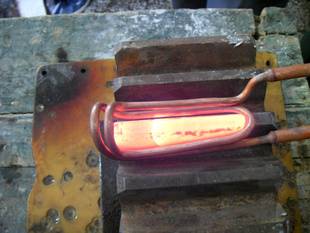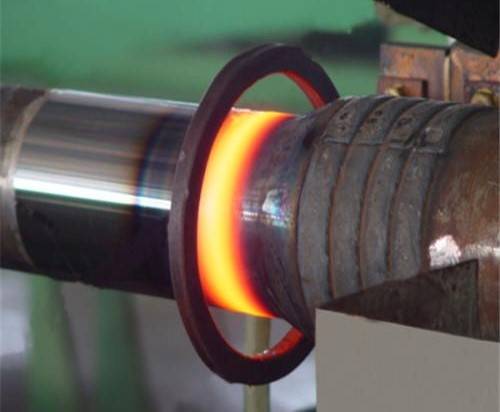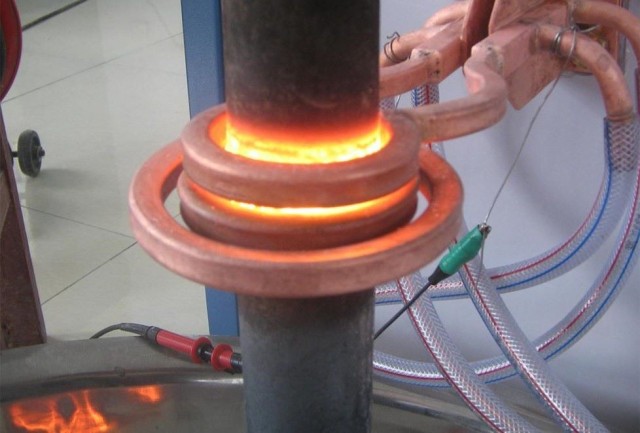Vacuum Tube Furnace Overview
Working Method and Features
The vacuum tube furnace operates under a meticulously controlled environment to ensure precise heating processes. Initially, the furnace is evacuated to a pre-determined vacuum level, effectively removing any residual gases that could compromise the heating process. Following this, high-purity nitrogen or an ammonia decomposition atmosphere is introduced into the furnace. This protective gas not only maintains an inert environment but also prevents oxidation and decarburization of the materials being heated, ensuring their integrity and quality.
A critical component of the furnace's operation is the inclusion of a stirring fan. This fan plays a pivotal role in achieving uniform temperature distribution throughout the furnace chamber. By continuously circulating the protective gas, the stirring fan helps in dissipating heat evenly, thereby ensuring that the entire load within the furnace reaches the desired temperature consistently. This uniformity is essential for the precise control of thermal treatments, which is crucial for the final properties of the materials being processed.
In summary, the vacuum tube furnace's operation is a blend of advanced technology and meticulous process control, designed to deliver oxidation-free and decarburization-free heating, while maintaining high temperature uniformity through the use of a stirring fan.
Heat Generator and Furnace Design
The heat generator is strategically positioned on both sides and beneath the furnace, facilitating efficient heat distribution through integrated circulating air ducts and heat circulation fans. This configuration ensures that the entire furnace chamber is uniformly heated, which is crucial for the consistent melting of non-ferrous metals and alloys with melting points around 1000°C. The furnace lid operates automatically, allowing for the simultaneous or sequential curing of one or two ducts, thereby optimizing the process efficiency.
Heated by high-performance electric heating elements, the furnace is engineered to handle the rigorous demands of high-temperature applications. The furnace structure itself is constructed from heat-resistant stainless steel, which not only withstands the extreme temperatures but also ensures longevity and durability. Throughout the heating and cooling cycles, the furnace is continually protected by a high-purity nitrogen gas environment. This protective measure is essential for maintaining a bright, oxidation-free surface, which is critical for the integrity and quality of the final product.
| Feature | Description |
|---|---|
| Heat Generator Positioning | Located on both sides and underneath the furnace |
| Heating Elements | Electric heating elements for efficient heat generation |
| Material | Heat-resistant stainless steel |
| Protection | High-purity nitrogen gas during heating and cooling |
| Lid Operation | Automatic opening and closing for one or two ducts |
| Application | Melting non-ferrous metals and alloys with melting points around 1000°C |
Quenching Methods
Single-Liquid Quenching
In the process of single-liquid quenching, a workpiece is subjected to rapid cooling using a single, specified coolant within the controlled environment of a vacuum tube furnace. This method is particularly effective for achieving uniform cooling rates, which are crucial for enhancing the mechanical properties and microstructural integrity of the material.
The choice of coolant is critical and often depends on the specific requirements of the material being treated. Common coolants include water, oil, and various salts, each offering distinct cooling characteristics. For instance, water is known for its rapid cooling ability, which can lead to high thermal gradients and potentially induce stress within the workpiece. Conversely, oils provide a slower, more controlled cooling process, which is beneficial for reducing internal stresses and preventing cracking.

During the quenching process, the vacuum environment ensures that the workpiece remains free from oxidation and contamination, preserving its surface integrity and mechanical properties. The uniformity of the cooling process is further enhanced by the presence of a stirring fan, which ensures consistent temperature distribution throughout the furnace.
Single-liquid quenching is a versatile technique, applicable to a wide range of materials and applications, from industrial components to specialized alloys. Its simplicity and effectiveness make it a preferred choice in many high-precision manufacturing processes.
Pre-Cooling Quenching
Pre-cooling quenching involves initially lowering the workpiece to a specific temperature before it is fully immersed in the coolant. This method is particularly crucial for small to medium-sized parts that undergo high-temperature quenching, as it significantly influences the subsequent quenching deformation. The general rule indicates that direct oil or air cooling immediately after the workpiece transitions from a hot chamber to a cold chamber can result in dimensional changes. However, if the workpiece is pre-cooled appropriately, it can maintain its original dimensions before heat treatment.
| Condition | Effect on Workpiece Size |
|---|---|
| Direct Cooling | Leads to size change |
| Appropriate Pre-Cooling | Maintains original dimensions |
| Excessive Pre-Cooling | Causes swelling |
The optimal pre-cooling time typically ranges between 0.5 to 3 minutes for workpieces with an effective thickness of 20 to 60mm. This controlled pre-cooling phase ensures that the workpiece is stabilized at the right temperature, minimizing the risk of deformation during the subsequent quenching process.
Dual-Liquid Quenching
Dual-Liquid Quenching is a sophisticated method that involves a two-step cooling process to achieve precise control over the temperature and structure of the workpiece. Initially, the workpiece is submerged in water, which provides a rapid cooling phase. This rapid cooling helps to stabilize the outer layer of the workpiece, preventing the formation of undesirable microstructures.
After the initial water quench, the workpiece is then transferred to an oil bath for the second phase of cooling. The oil bath offers a slower cooling rate compared to water, allowing for more controlled heat dissipation. This slower cooling process is crucial for ensuring that the internal structure of the workpiece reaches the desired level of hardness without introducing excessive stresses.
The dual-liquid quenching method is particularly advantageous for materials that require both rapid cooling to prevent overheating and slower cooling to achieve the necessary mechanical properties. This technique is widely used in industries where the quality and consistency of the final product are paramount, such as in the manufacturing of high-precision components and tools.

| Step | Coolant | Purpose |
|---|---|---|
| 1 | Water | Rapid cooling to stabilize outer layer |
| 2 | Oil | Slow cooling to achieve desired hardness |
By combining the benefits of both water and oil, dual-liquid quenching provides a comprehensive solution for achieving optimal material properties in the workpiece.
Graded Quenching
Graded quenching is a sophisticated cooling technique where the workpiece is initially immersed in a molten salt bath, followed by air cooling. This method is designed to achieve a controlled rate of cooling, which helps in obtaining specific microstructures and mechanical properties in the material.
When the workpiece is first submerged in the molten salt, it experiences rapid cooling due to the high thermal conductivity of the salt. This phase is critical as it determines the initial rate at which the workpiece cools down, which in turn influences the formation of the material's microstructure. The molten salt used in this process is typically a mixture of salts like sodium nitrate and potassium nitrate, which have high thermal stability and can maintain a consistent temperature.
After the initial rapid cooling in the molten salt, the workpiece is then exposed to air cooling. This stage allows for a more gradual decrease in temperature, providing an opportunity for the material to stabilize and reduce internal stresses. The air cooling phase is crucial for achieving the desired final properties of the workpiece, such as hardness and toughness.

The combination of these two cooling phases—rapid in the molten salt and gradual in air—enables graded quenching to offer a balance between the benefits of rapid cooling and the need for controlled thermal gradients. This makes it particularly useful for materials that require precise control over their thermal history to achieve optimal performance.
Hot Bath Quenching
Hot bath quenching involves immersing the workpiece in a bath of high-temperature nitrate salt or alkali, which serves as an effective medium for rapid cooling. This method is particularly advantageous for achieving uniform cooling rates and minimizing thermal stresses within the material. The high-temperature bath not only facilitates rapid heat extraction but also ensures that the workpiece undergoes a controlled cooling process, which is crucial for preserving the desired microstructural properties.
Following the immersion in the high-temperature bath, the workpiece is typically subjected to air cooling. This secondary cooling phase allows for the dissipation of residual heat, ensuring that the workpiece reaches ambient temperature gradually. The combination of bath cooling and air cooling provides a comprehensive quenching process that balances speed and control, thereby enhancing the overall quality and consistency of the treated material.
| Cooling Medium | Temperature Range | Advantages |
|---|---|---|
| Nitrate Salt | 300°C - 600°C | Rapid, uniform cooling; minimizes thermal stresses |
| Alkali | 200°C - 500°C | Effective heat extraction; controlled cooling process |
The choice of nitrate salt or alkali depends on the specific requirements of the material being treated, including its composition, desired hardness, and the level of thermal stress tolerance. By carefully selecting and controlling the cooling medium and temperature, hot bath quenching can be optimized to achieve the best possible results in terms of material properties and performance.
Isothermal Quenching
Isothermal quenching is a specialized technique where the workpiece is immersed in a bath of isothermal molten salt for controlled cooling. This method is particularly effective for achieving uniform and predictable microstructural changes, which is crucial for certain metal alloys that require specific mechanical properties.
The process begins with the workpiece being heated to the desired temperature within the vacuum tube furnace. Once the heating cycle is complete, the workpiece is rapidly transferred into the molten salt bath, which is maintained at a constant temperature. The molten salt, often a mixture of salts such as potassium nitrate and sodium nitrate, provides a homogeneous heat sink that allows for precise temperature control during the quenching process.
Key advantages of isothermal quenching include:
- Uniform Cooling: The isothermal bath ensures that the workpiece cools uniformly, minimizing thermal gradients that can lead to distortion or cracking.
- Microstructural Control: By maintaining a constant quenching temperature, this method allows for precise control over the microstructural transformations, which can significantly enhance the mechanical properties of the material.
- Reduced Oxidation: The protective atmosphere of the molten salt bath prevents oxidation and decarburization, resulting in a clean and oxidation-free surface on the workpiece.
The choice of molten salt composition and temperature is critical and is typically determined based on the specific requirements of the material being processed. This method is particularly favored in industries where the quality and consistency of the final product are paramount, such as aerospace and automotive components.
In summary, isothermal quenching offers a sophisticated approach to cooling that leverages the properties of molten salts to achieve uniform and controlled microstructural changes, thereby enhancing the overall quality and performance of the workpiece.
Related Products
- Vertical Laboratory Quartz Tube Furnace Tubular Furnace
- Vacuum Hot Press Furnace Heated Vacuum Press Machine Tube Furnace
- Vacuum Hot Press Furnace Machine Heated Vacuum Press
- Multi Zone Laboratory Quartz Tube Furnace Tubular Furnace
- 1700℃ Laboratory Quartz Tube Furnace with Alumina Tube Tubular Furnace
Related Articles
- Installation of Tube Furnace Fitting Tee
- Advanced Laboratory Furnaces: Box, Muffle, and Tube Options for High-Temperature Applications
- Vacuum Laboratory Furnaces in Advanced Materials Research
- Infrared Heating Quantitative Flat Plate Mold: Design, Applications, and Benefits
- The Versatility of Tube Furnaces: A Guide to Their Applications and Benefits














